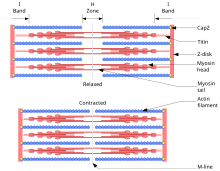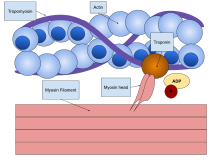
The sliding filament theory explains the mechanism of muscle contraction based on muscle proteins that slide past each other to generate movement.[1] According to the sliding filament theory, the myosin (thick filaments) of muscle fibers slide past the actin (thin filaments) during muscle contraction, while the two groups of filaments remain at relatively constant length.
The theory was independently introduced in 1954 by two research teams, one consisting of Andrew Huxley and Rolf Niedergerke from the University of Cambridge, and the other consisting of Hugh Huxley and Jean Hanson from the Massachusetts Institute of Technology.[2][3] It was originally conceived by Hugh Huxley in 1953. Andrew Huxley and Niedergerke introduced it as a "very attractive" hypothesis.[4]
Before the 1950s there were several competing theories on muscle contraction, including electrical attraction, protein folding, and protein modification.[5] The novel theory directly introduced a new concept called cross-bridge theory (classically swinging cross-bridge, now mostly referred to as cross-bridge cycle) which explains the molecular mechanism of sliding filament. Cross-bridge theory states that actin and myosin form a protein complex (classically called actomyosin) by attachment of myosin head on the actin filament, thereby forming a sort of cross-bridge between the two filaments. The sliding filament theory is a widely accepted explanation of the mechanism that underlies muscle contraction.[6]


- ^ Silverthorn, Dee Unglaub (2016). "Muscles". Human Physiology: An Integrated Approach (7th ed.). San Francisco, CA: Pearson. pp. 377–416. ISBN 978-0-321-98122-6.
- ^ Huxley, Hugh E. (2004). "Fifty years of muscle and the sliding filament hypothesis". European Journal of Biochemistry. 271 (8): 1403–1415. doi:10.1111/j.1432-1033.2004.04044.x. PMID 15066167.
- ^ Andersen, O. S. (2004). "50-Year Anniversary of Sliding Filament". The Journal of General Physiology. 123 (6): 629. doi:10.1085/jgp.200409079. PMC 2234570.
- ^ Huxley, A.F.; Niedergerke, R. (1954). "Interference microscopy of living muscle fibres". Nature. 173 (4412): 971–973. Bibcode:1954Natur.173..971H. doi:10.1038/173971a0. PMID 13165697. S2CID 4275495.
- ^ Rall, Jack A. (2014). Mechanism of Muscular Contraction. New York: Springer Science+Business Media. pp. 21–23. doi:10.1007/978-1-4939-2007-5. ISBN 978-1-4939-2006-8. S2CID 26766432.
- ^ Wood, A.W. (2012). "Skeletal muscle biophysics". Physiology, Biophysics, and Biomedical Engineering. Taylor & Francis. pp. 158–162. ISBN 978-1-46-655279-1.
© MMXXIII Rich X Search. We shall prevail. All rights reserved. Rich X Search
